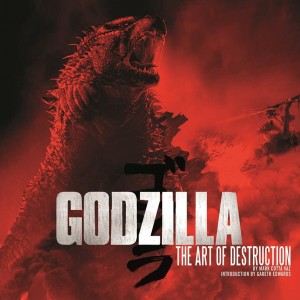Godzilla: The Art of Destruction
Author: Mark Cotta Vaz. Foreword by Gareth Edwards.
Publisher: Insight Editions
ISBN-10: 1-6088-7344-7
ISBN-13: 978-1-6088-7344-9
Disclosure: A free copy of this book was furnished by the publisher for review, but providing a copy did not guarantee a review. This information is provided per the regulations of the Federal Trade Commission.
This is the official “art of” coffee-table film book of the new May 2014 Godzilla theatrical feature, produced by Legendary Pictures and Warner Bros., and released by the latter. If you have any interest in this particular Godzilla movie, this is a worthwhile, maybe even necessary purchase. If you want information about any of the 28 Godzilla movies produced by Toho Co., Ltd. in Japan since 1954, or the 1998 American theatrical feature by Tri-Star Pictures, you will not find it here. This is not a book about the King of the Monsters over the years.
But for the details about the May 2014 123-minute feature, this book is exhaustive. There is a foreword by Director Gareth Williams, who is quoted throughout the book so extensively that he might as well have been credited as its co-author. Most of the frequent illustrations, many of them full-page, are the production staff’s concept paintings rather than photographs from the film, although those are also included, especially of the human cast. In addition to presenting a visual summary of the entire plot, there is a concentration upon the new design of Godzilla, and upon his (its?) monster opponents in this movie, the two giant wasplike MUTOs (Massive Unidentified Terrestrial Organisms).
“In their backstory, Godzilla and the MUTO go back 250 million years. Earth’s atmosphere was still developing, the planet was highly radioactive, and creatures depended on radiation for their life cycle in the same way plants absorb and photosynthesize sunlight. In that savage, primordial world, Godzilla was the alpha predator.” (p. 22) There were many Godzillas at this time, and many MUTOS to prey upon them. A Godzilla was larger and able to defeat any individual MUTO, but the MUTOS attacked in pairs, a male and a female, often killing the Godzilla and laying the female’s eggs in its body.
This is learned during the course of the movie. In the new plot, the 1954 appearance of the original Godzilla near Japan, and the nuclear tests that were supposed to have awakened it, were a cover-up for its being awakened by a deep-sea expedition, and an attempt to kill the monster with atomic bombs. The movie jumps to 1999 when two Project Monarch scientists discover a gigantic prehistoric chrysalis from which something has just emerged, in the ruins of a Philippine mine. Simultaneously, a (fictional) Japanese nuclear reactor is destroyed by a supposed earthquake and meltdown that leaves the site so radioactive that its city must be evacuated and quarantined. In 2014, the movie’s human protagonists learn that the reactor was really destroyed by the MUTO from the Philippine chrysalis, attracted by the reactor’s radioactivity. The site’s quarantine is another cover-up to hide the presence of a second chrysalis, from which a new MUTO is hatching. The two MUTOs and the undersea Godzilla are drawn to each other for a cataclysmic battle during which San Francisco is destroyed.
This synopsis does not go into the human-interest story within the movie, which is also covered.
Godzilla: The Art of Destruction goes as far as showing over two dozen preliminary designs for the “new look” of Godzilla; all of which are, frankly, almost indistinguishable from the original 1954 design. (Godzilla in 1954 was said to be 40 feet tall. Now he is 350 feet tall. He does look more feral.) The differences in the fins upon Godzilla’s back of the different designs are pointed out. Similarly, the designs of the MUTO monsters are shown in detail.
At any rate, for those who want to know all about the 2014 Godzilla, this $45.00, 156-page coffee-table art book is made to order.






